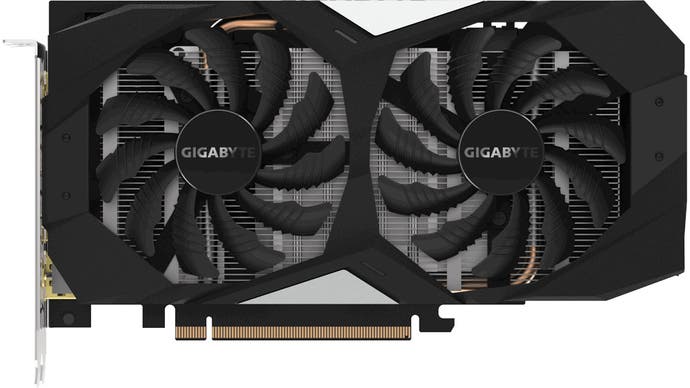GTX 1660 benchmarks: a strong 1080p performer
The new entry-level Turing card tested.
The GTX 1660 is the second GTX card to appear in Nvidia's Turing lineup, dropping the specialised hardware of the RTX cards in order to deliver strong gaming performance at a lower price point - in this case, at just £200/$220. The GTX 1660 Ti proved to be a worthy alternative to the RTX 2060, offering around 85 per cent of the performance at 75 per cent of the price, so will we see a similar value from the even cheaper card? That's what this article intends to find out, as we examine in-game performance for the GTX 1660 compared to its closest competitors.
Before we get into the results, it's worth briefly covering the features of the new card. While you don't get hardware-accelerated RTX and deep learning super sampling (DLSS), the GTX 1660 still includes some of other benefits of the new Turing architecture, including support for variable rate shading (VRS) - which can boost performance significantly in games that support it, a list that contains just one entry at the moment: Wolfenstein 2.
Looking at the specifications for the GTX 1660, it's easy to see where Nvidia have made cutbacks in order to hit a lower price point. The modern GDDR6 video memory used in all other Turing cards thus far has been swapped for previous-gen GDDR5, meaning we see a 33 per cent reduction in memory speeds compared to the GTX 1660 Ti despite an equally-sized 192-bit bus. There are fewer CUDA cores in the new card too, although frequencies have been boosted somewhat to compensate. We'd expect the GTX 1660 to perform in between the GTX 1060 and GTX 1660 Ti then, but where exactly does it fall?
To answer this question, we tested the GTX 1660 in nine recent games, from Assassin's Creed Odyssey to The Witcher 3. Given the horsepower provided by this calibre of hardware, our testing will focus on 1080p and 1440p resolutions; you shouldn't expect playable frame-rates at 4K even with reduced graphical settings in modern games.

| GTX 1060 | GTX 1660 | GTX 1660 Ti | RX 580 | RX 590 | |
|---|---|---|---|---|---|
| GPU cores | 1280 | 1408 | 1536 | 2304 | 2304 |
| VRAM | 6GB GDDR5 | 6GB GDDR5 | 6GB GDDR6 | 8GB GDDR5 | 8GB GDDR5 |
| Memory Bus | 192-bit | 192-bit | 192-bit | 256 bit | 256 bit |
| Bandwidth | 192GB/s | 192GB/s | 288GB/s | 256GB/s | 256GB/s |
| Boost Clock | 1708MHz | 1785MHz | 1770MHz | 1340MHz | 1545MHz |
| Processor | GP106 | TU116 | TU116 | Polaris 20 | Polaris 30 |
Our benchmark results are shown below for each of the games and resolutions we tested in. We've selected some interesting comparisons by default, but you can use the controls to the right of each video to add or remove data points yourself. Press play on the video, and you'll see how each card handles the test scene as it plays out. If you prefer a single glanceable summary, we have more traditional bar charts as well - and this is all you'll see on mobile. If you're on a desktop, these bar charts gain some extra features - you can mouse over to see each card's worst, best and average performance, and you can click on the chart to swap between absolute frame-rates and percentages. With that explained, let's get into the results.
Assassin's Creed Odyssey
Our first game is one of the most challenging in our arsenal: the most recent Assassin's Creed title, Odyssey. This game's ultra high preset is a punishing one indeed, with the peaceful vistas and detailed texture work providing a heavy workout even for modern graphics hardware. The GTX 1060 manages a 40fps average at 1080p, dropping to 29fps at 1440; the GTX 1660 improves on this with averages of 46fps and 36fps, respectively. That works out to an advantage of around 15 per cent at 1080p and 25 per cent at 1440p. Meanwhile, the GTX 1660 remains comfortably ahead of the RX 580 and RX 590 at all resolutions tested by at least 20 per cent.
AC Odyssey: Ultra High, TAA
Assassin's Creed Unity
Assassin's Creed Unity may be four years older than its little brother, but it's still a challenging test thanks to the depth of field effect used almost constantly in this early scene overlooking the cathedral of Notre Dame. The GTX 1660 is consistently around 15 per cent ahead of its predecessor, the GTX 1060. If we consider the AMD cards, the advantage the GTX 1660 possesses over the RX 590 is 10 per cent at 1080p, although this narrows to just six per cent at 1440p where the AMD card's greater CPU utilisation becomes less of a concern.
Assassin's Creed Unity: Ultra High, FXAA
Battlefield 1
Battlefield 1 in DirectX 12 is a game that has consistently favoured AMD hardware, and that trend continues with the recently released RX 590 against the even newer GTX 1660. The AMD card is in a dead heat with Nvidia's latest, coming barely behind at 1080p but squeaking out an imperceptible lead at 1440p. The GTX 1660 shows a strong improvement over the GTX 1060 here, measured at 17 per cent at 1080p and nearer 20 per cent at 1440p.
Battlefield 1: Ultra, TAA
Crysis 3
As games and their engines evolve, developers tend to add support for new tricks and features to wring out some extra performance from newer graphics hardware. That means that older games tend to be relatively harder tests for new graphics hardware, particularly entry-level cards like the GTX 1660, and that's what we see with Crysis 3. This game, released nearly six years ago now, still runs faster on the GTX 1660 than on the GTX 1060, but the margin between the two cards is much smaller than in more modern titles. Specifically, we're looking at just an eight per cent gap at 1080p and even less at 1440p. Once again, the GTX 1660 and the RX 590 are dead even.
Crysis 3: Very High, SMAA T2X
Far Cry 5
As we return to a newer title in Far Cry 5, you can see a wider gap open back up between the GTX 1060 and its replacement, the GTX 1660. We measure it as about 15 per cent at 1080p and a few percentage points higher at 1440p. Meanwhile, the RX 590 takes the first meaningful victory against the GTX 1660, coming up a few percentage points ahead at 1440p despite being level at 1080p.
Far Cry 5: Ultra, TAA
Ghost Recon Wildlands
Ghost Recon Wildlands is an easy enough game to run and enjoy on its high preset, but crank things up to ultra and even high-end graphics cards start having serious difficulties. We're using those ultra graphical settings here, and you can see it does a number on the GTX 1660 with averages of only 45fps at 1080p and 35fps at 1440p. That's still 14 per cent faster than the GTX 1060 6GB in the same test, mind you.
Ghost Recon Wildlands: Ultra, TAA
Rise of the Tomb Raider
It's a similar story in Rise of the Tomb Raider, where the GTX 1660 manages at 13 per cent lead over the GTX 1060 6GB at both 1080p and 1440p. The RX 590 remains a close challenger to the new Nvidia GeForce card though, with a one per cent deficit at 1080p but a three per cent lead at 1440p.
Rise of the Tomb Raider: Very High, SMAA
Shadow of the Tomb Raider
The GTX 1660 shows its aplomb in modern titles well in Shadow of the Tomb Raider, the final part of the Tomb Raider remake trilogy. The GTX 1660 goes out to a 27 per cent lead at 1080p over the GTX 1060, the highest differential we've seen so far. At 1440p, things are closer, with a 12 per cent advantage going to the newer card.
Shadow of the Tomb Raider: Highest, TAA
The Witcher 3
The Witcher 3 is one of the best RPGs to be released this decade, although its horse-pathing AI sometimes brings our test scene to a grinding halt. It's also a good test for mainstream GPUs, which should be able to hit 60fps with max settings (apart from Hairworks off) at 1080p and close to that figure at 1440p. The GTX 1660 improves 17 per cent over the GTX 1060 at Full HD, managing a comfortable 77fps on average, but only hits 52fps at 1440p. The Witcher is another game where AMD's RX 580 and RX 590 perform competitively, with the RX 580 nearly besting the brand new Nvidia card and the RX 590 proving the better performer overall.
Witcher 3: Ultra, Post-AA, No Hairworks
That brings our look at GTX 1660 performance to a close. In the meantime, why not check out the full GTX 1660 Digital Foundry review on YouTube?









